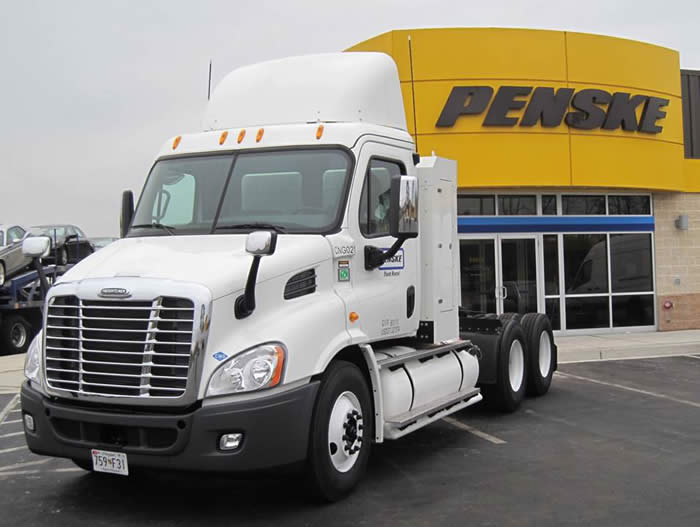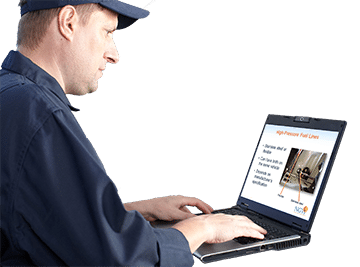By Kasia McBride, Marketing Manager, NGVi

Technicians are often kinesthetic learners, which means they absorb information better when given the opportunity to manually practice the skills being taught through hands-on exercises. Though this form of training can be highly effective, and in some circumstances necessary, recently many organizations have added e-learning to their training delivery mix as a scalable, economical alternative. Determined in cost savings alone, the value of e-learning can be substantial.
For years, traditional classroom training was the most practical option available. But for some organizations, scheduling this type of training can be more difficult, especially when staff are geographically dispersed.

“Because of its convenience and flexibility, e-learning allows us to address many of the training needs of our maintenance associates,” said Matt Krasney, Director of Alternative Fuels at Penske Truck Leasing, and one of NGVi’s customers. “With more than 231,000 vehicles operating across nearly 1,000 locations, it is essential that Penske provide high-quality training that is conveniently available to all of our technicians. While hands-on, in person training remains the foundation of our training program, NGVi has been instrumental in developing a custom e-learning solution unique to Penske that addresses the specific needs of our growing natural gas fleet.“
E-learning has many benefits compared to traditional classroom training, and can produce great results by decreasing costs while still improving employee performance. Key factors:
24/7 Accessibility
E-learning courses are accessible to technicians around the clock. This makes it possible for them to learn the content at their own pace and in comfortable settings. Unlike instructor-led training, participating in e-learning ensures that faster learners may complete their training sooner, which enhances their productivity. In turn, slower learners can still master the subject matter without the stress of falling behind. With e-learning, employees can receive training anytime and anywhere—at work, home, or even while commuting. Also, in large organizations where employees work in different time zones, e-learning makes it possible for an employer to offer training without time constraints on resources.
Flexibility
In addition to being offered around the clock, e-learning can be completed in short chunks of time that fit around a technician’s work schedule. Unlike day-long instructor led training, a technician does not need to be out of the shop an entire day to get effective training. Instead, e-learning offers a set amount of learning, typically divided into modules, which allows technicians to be trained around their other daily duties without a major interruption.
Reduced Training Costs
Generally speaking, the more training your employees need, and the more geographically dispersed they are, the greater the training costs. If technicians must travel out of town to receive training, often a significant portion of the costs are due not to the cost of the training itself, but to employee travel expenses such as airfare, lodging and meals. With e-learning, these costs are eliminated since there is no longer a need for them to leave their place of work.
Condensed Delivery Time and Rapid Deployment
E-learning takes less time than instructor-led training because there are no interactions with fellow students, student questions to be answered or breaks required. A traditional two-day instructor led curriculum can often be delivered in about 10 hours of e-learning, thus saving the employer in lost production costs. In addition, e-learning can be delivered quickly and conveniently, so that technicians are able to acquire new information or skill sets almost immediately.
Learn
With e-learning, every learner proceeds at his or her own pace. When learners have control over the amount of content they cover at one time, they are better prepared to retain the information. hnicians who have access to online training don’t have to rush through content presented in a classroom setting or move at the pace of the rest of the students. They are given the opportunity to fully absorb what is taught before they progress with additional course material. There is also the ability to revisit or replay sections of the e-learning training that might not have been mastered the first time around.
Multiple Languages
E-learning material can be easily translated into other languages. This facilitates delivery of training to diverse or multilingual workforces. A case in point is Waste Management, which employs drivers and technicians who speak not only English, but also Spanish and French. NGVi has developed customized training for Waste Management’s drivers and technicians that is translated into those languages.
“Waste Management’s commitment to providing quality safety and technical training is unparalleled in the industry, going far beyond the standard safety training programs,” said Neil Allison, Manager of Fleet Training at Waste Management. “These e-learning courses are a convenient way for our technicians and drivers to gain the knowledge and skills needed to do their jobs safely and effectively, without having to send them off site. A big plus: we were able to have teams trained in French, Spanish, and English, supporting sites all over North America.”
The unique fuel properties, components and inspection requirements of NGVs demand specialized maintenance knowledge, making technician training vital. Adding e-learning to the NGV training delivery mix gives managers just another tool to provide NGV technicians with the knowledge and skills they need to perform their jobs, but with more focus, in less time and at a significantly lesser cost.
